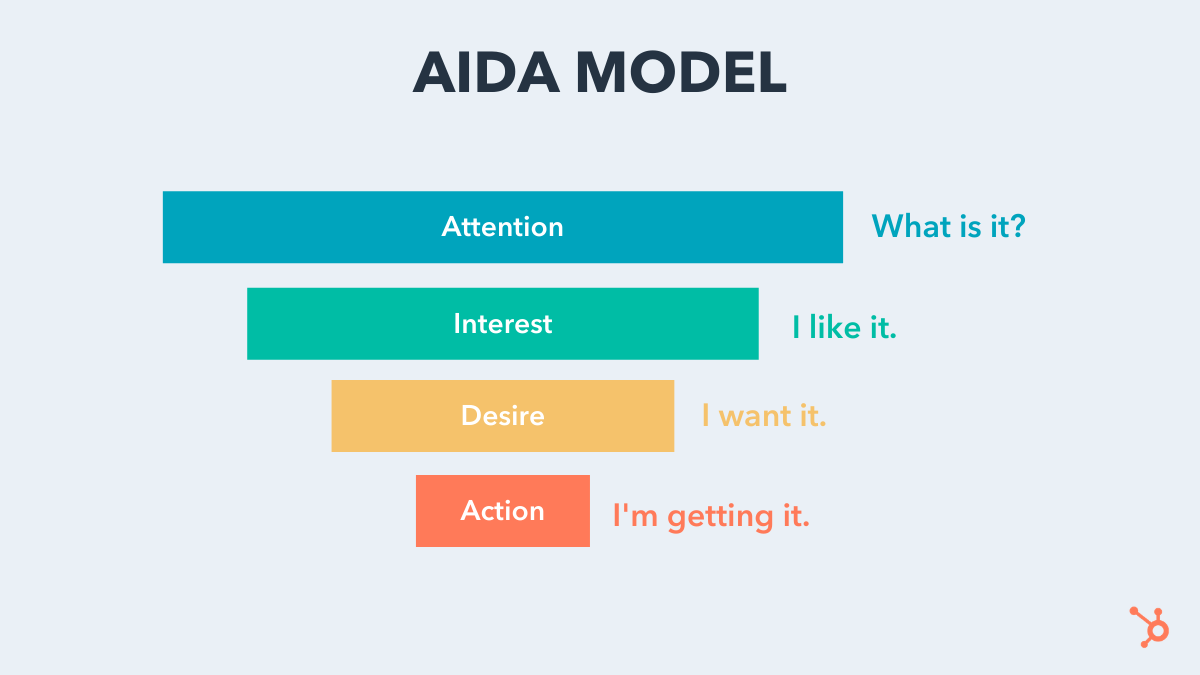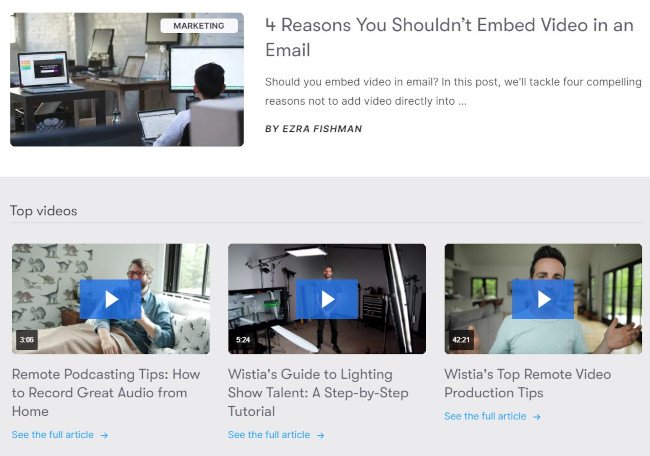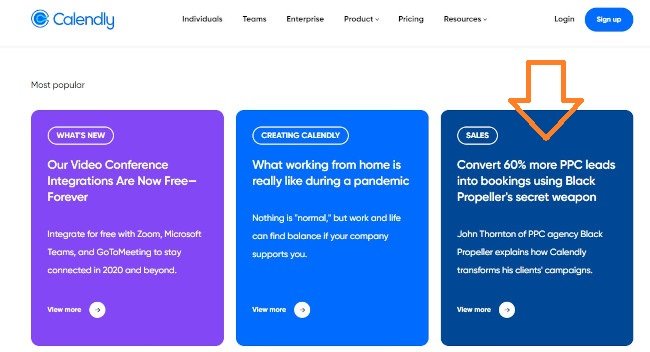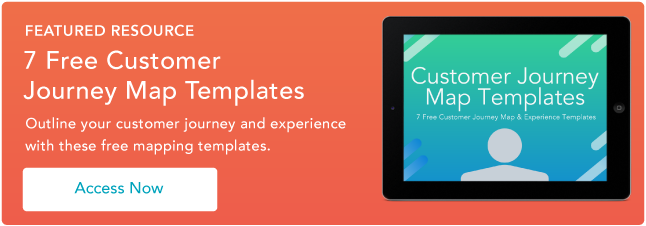In 1898, Elias St. Elmo Lewis, an eventual inductee of the Advertising Hall of Fame, anonymously wrote a column about three advertising principles he found useful throughout his career in a printing magazine called The Inland Printer, one of the most influential American magazines of the 19th century.
In his column, he states that a successful advertisement should always follow a specific formula.
“The mission of an advertisement is to attract a reader, so that he will look at the advertisement and start to read it; then to interest him, so that he will continue to read it; then to convince him, so that when he has read it he will believe it. If an advertisement contains these three qualities of success, it is a successful advertisement.”
In other words, copy is only good if it attracts attention, generates interest, and creates conviction, in that order.
Over a century later, Lewis’ principles still ring true. They’re expressed as an acronym, AIDA, and widely used in the advertising industry. In the digital age, brands have even based their entire marketing strategy on the AIDA model.
Before we cover how you can apply the AIDA model to your own content marketing strategy, let’s go over what it is and why it works.
The AIDA Model
The AIDA model describes the four stages a consumer goes through before making a purchasing decision. The stages are Attention, Interest, Desire, and Action (AIDA). During these four stages, your content will ideally attract attention to your brand, generate interest in your product or service, stimulate a desire for it, and spur action to try or buy it.
Brands use the AIDA model to determine the way they should craft and distribute marketing messages to their target audience at each stage of the buyer’s journey.
The AIDA model is considered a hierarchy of effects model, which means consumers must move through each stage of the model to complete the desired action. Just like a typical marketing funnel, each stage has fewer consumers than the previous one.

How to Apply the AIDA Model to Your Marketing
By creating campaigns and structuring your website with the AIDA model in mind, you can get more control over your prospects’ paths to a purchasing decision.
In theory, as they progress through each stage of the model, consumers who learn about your brand will develop certain feelings or emotions about your product or service, which is what ultimately compels them to act.
Here’s what you can do to implement AIDA:
Attract Attention
If your content can grab their attention and deeply engage them, your target audience will start to become curious about what your company actually does.
In this stage, the consumer is asking, “What is it?”
In order to get to this stage, you must first get your content in front of them. This comes with increased brand awareness and effective messaging.
Example
Effective content marketing is one method of attracting visitors to your website. If you create content that solves their problems and focuses on their passions, you’ll be able to draw them in and provide a solution. When executed effectively, your target audience should be able to discover your content through Google, social media, and other channels.
Wistia does this well with their content marketing, producing not just educational blog posts that drive traffic but also entertaining or inspiring “shows.” This tactic allows them to not just address the pains their prospects have but also go above and beyond to make solving that problem easier (and, in some cases, entertaining). Leaning into video as a medium instead of just blogging ties into their product and mission, keeping Wistia’s solutions top of mind as prospects consume this content.

Generate Interest
Once your target audience is interested in your product or service, they’ll want to learn more about your brand, the benefits of your solution, and your potential fit with them.
In this stage, the goal is to get them to think, “I like it.”
In order to get to this stage, your content must be persuasive and engaging. While the first stage of AIDA is capturing their attention, this stage is about holding it. You can do this with a hook.
Example
Let’s say your content marketing was effective in drawing them to the website to learn about a pain, problem, or need they have. You might then “hook” them with engaging storytelling that demonstrates the why behind your solution.
Stories resonate with humans, and it’s a simple way to convey information in a way that stimulates empathy and curiosity.
To generate enough excitement in your prospects to compel them to act, you need to make sure their affinity for your brand hits a certain threshold. The more aligned you are with their needs and values, the more likely you are to achieve success.
Below the Fold is a service that delivers relevant news articles to its users. It generates interest with its hook: “Stories that don’t make it to the front page.” The intrigue in this line opens up a loop (What have I been missing without this service?) while highlighting their value proposition of surfacing stories that aren’t getting coverage but are still important.

Stimulate Desire
People do business with those they know, like, and trust. The first two stages of the AIDA model establish the know and the like.
The goal of this stage is to change “I like it” to “I want it.”
And that’s done by cementing in the final piece of the puzzle: Trust.
To do this, keep serving them content. Make sure they subscribe to your blog, follow you on social media, and download your offers. The more prospects interact with your brand, the more they’ll trust you, boosting the chances they’ll eventually buy your product or service.
Example
The prospects you’re most likely to close are the consumers who envision a future with you — they already enjoy consuming your content and think your product or service will be even better.
For this reason, you must institute a gap between where they are and where they could be with your solution. At the same time, you must establish social proof with case studies and testimonials.
“Before and After” style content is a great example of how to stimulate desire while gaining trust. Check out the headline on this case study by Calendly: “Convert 60% more PPC leads into bookings using Black Propeller’s secret weapon.” This helps a prospect envision a future with this product (What would my life be like if I achieved similar results?). The “before” is them at their current stage, and the “after” is the vision of them with a 60% increase in conversions. Then, if they read the full case study, they get exposed to social proof from a customer just like them.

Spur Into Action
After you generate enough desire for your product or service, give your prospects the chance to act on it. After all, what’s the point of creating content and building deep relationships with prospects if there isn’t a clear next step?
The goal is to get them to decide, “I’m getting it.”
No matter what the “next step” is, you should compel them to respond with low-friction but high-incentive calls to action.
Example
Whether they’re far away or close to a purchasing decision, the next step that you present should be “high-value.” In other words, it must help them in some way.
If they understand what the outcome of your offer is and find it valuable to them, they’ll be more likely to act (since they aren’t simply committing to a sales call or sales content).
Consider exactly how you can provide that value while motivating them to engage with you.
The CTA for this “next step” or offer should be prominent, clear, and uncomplicated. Perhaps it’s a button or banner that spells out what action they must take and what they get if they do. By eliminating friction in the process, you increase your likelihood of success.
Nerdwallet, a personal finance site that provides resources on everything from credit to mortgages, has such a CTA. The idea is that they can engage their audience and compel them to action by offering a comparison tool. They highlight this tool directly on their homepage with a grabby headline and value-driven subheadline along with a high-contrast button. The setup is uncomplicated and friction-free. Nerdwallet is simultaneously able to generate leads while empowering and delighting those leads with high-value information.

AIDA Drawbacks
Now that you are familiar with the AIDA framework and how it operates, you should also consider some of its limitations:
1. It doesn’t take into account non-linear buyer’s journeys.
AIDA does a fantastic job of describing a linear thought process for a purchasing decision. However, not all purchasing decisions are linear.
A prospective customer might get their interest peaked but ultimately choose a different solution, only coming back to the original provider if their needs aren’t met.
More commonly, someone might have a desire for a solution before being aware of it and taking action to find it (thus experiencing the Desire and Action before the Attention and Interest).
2. It doesn’t take into account impulse purchases or super short sales cycles.
In addition to a non-linear journey, a prospective customer might cycle through multiple stages of AIDA at the same time — all four for an impulse buy or emergency purchase.
3. It’s only a small piece of a holistic business strategy.
AIDA is also limited to first-time purchases. Some organizations try to align their strategy around marketing funnels like AIDA, but this is a mistake. Funnels have customers as an output when they should be at the center of a growth strategy. After all, it’s easier to retain and/or upsell an existing customer than acquire a new one. In addition, with a little customer delight, you can earn testimonials and referrals, generating more attention, interest, and (therefore) customers.
AIDA doesn’t accommodate for this, which is why other models — like the flywheel — are more appropriate for holistic business strategy.
4. Focusing on one AIDA element per marketing tactic may not be effective.
Even when using a funnel for one particular aspect of your business rather than a holistic strategy, it can still be easy to fall into the trap of segmenting out the four letters of AIDA and applying one letter per each tactic in your marketing strategy. For example, you might think, “This blog post is to get their attention,” and only focus on that. However, a blog post should ideally attract awareness and generate interest… and at least get them to take some kind of action before they leave your site.
In other words, marketing should be able to cycle a prospect through multiple stages of AIDA. An effective ad, for example, might prompt three or four stages of AIDA, spurring a potential buyer to action.
5. It’s almost too simple.
AIDA might also be effective in conceptualizing the buying process in a consumer’s mind when they are faced with an ad or other piece of marketing collateral. However, AIDA may be too simplistic to describe the stages of a buying process, particularly for decisions that are more involved or nuanced. Today’s buyers have more resources at their disposal to research, comparison shop, etc.
Using the AIDA Framework
Despite its drawbacks, the AIDA model is a sturdy framework for guiding your audience through the buyer’s journey and spurring them to act. And if you apply it to your content marketing, you’ll be leveraging a proven formula that can consistently engage, persuade, and convert an audience into customers. However, it starts with knowing your customer journey.
Editor’s note: This post was originally published in October 2018 and has been updated for comprehensiveness.
![]()


